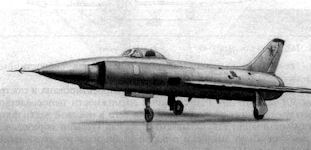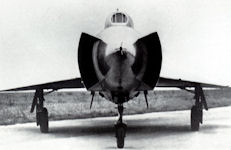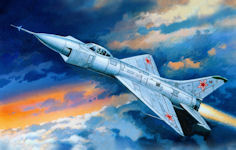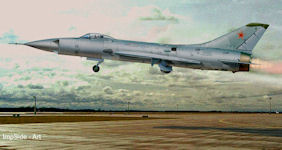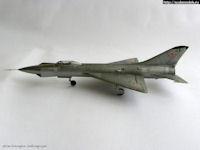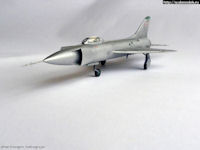T-49 Experimental aircraft
The T-49 from the experimental design bureau of P.O.Sukhoi Design Bureau was a further development of the Su-9 supersonic interceptor with a modified nose section, side air intakes and a powerful radar. Improved at the Design Bureau on the basis of one of the first production T-3 aircraft. Designed for testing adjustable isentropic air intake. For the first time, a new design was used on this aircraft: engine air intakes were located on the sides of the fuselage. The freed front part (nose) of the fighter allowed to place a radar there.
Passed factory tests in the first half of 1960 with test pilot A.A.Koznov. The aircraft was a connecting link, a stepping stone between the Su-9 and Su-15. Served to refine parts of the nose layout for a promising interceptor. There is not much information and photos on the prototype, in general, it’s understandable - once secret designs were “declassified” not so quickly.
T-49 (Sukhoi Design Bureau) - an experimental fighter - interceptor served to refine parts of the nose layout for a promising interceptor. A very interesting arrangement was proposed with two lateral sectorial intakes displaced a little back along the length of the fuselage to ensure the normal operation of the radar, and the station itself in the LFF under a stationary fairing. To reduce the loss of full pressure, the air intake was decided to make the so-called isentropic due to the special profiling of its flow part. This should have led to a significant increase in its efficiency, and, consequently, to improved characteristics of the power plant as a whole. The T-49 showed very good flight performance. As expected, the acceleration behavior of the aircraft was especially improved.
The K-8 complex was initially worked out on Yak-25K double interceptors equipped with Sokol-2K radar. Subsequently, the complex was installed on the supersonic Yak-27, which without problems allowed a large volume of the nose of the fuselage when the aircraft layout with the location of the engines on the wing. It was impossible to place such a large station on the T-3. Trying to solve this problem, Sukhoi Design Bureau built an experimental T-49 aircraft, which had side air intakes, which, due to habit, were located at the nose.
The stationary radome was carried forward, and the air intake was moved back, performing it in the form of two sectors. The flow part of the air intake and the channel was shaped so that it provided isentropic air compression, which minimized the loss of total pressure at the engine inlet. The construction was completed at the end of 1959 and at the beginning of 1960 the aircraft completed several flights, but failed to complete the test program due to lack of engines. Fortunately, this aesthetically unappealing project did not receive further development, affirming the aircraft design maxim that if it looks right, it is right [and the corollary, ugly planes cannot fly] - this plane did not look right. The new aircraft showed pretty good performance, but after a breakdown and a long repair with improvements, work on the project was stopped.
Sukhoi decided to use the more promising Orel radar, which had smaller antenna dimensions. The works received the T-3-8M code and subsequently formed the basis of the Su-11 serial interceptor. In second quarter of 1960 Sukhoi proposed the Su-15-40 interception system, consisting of the Su-15 aircraft, Vikhr-P radar (reduced version of the Smerch radar of the Tu-128) and K-40 (AA-6 'Acrid') missiles. Compared to the Su-11-8M complex, the new system offered better range, maximum launch distance and could launch from any direction including head-on. Construction of five Su-15 (designated T-58) prototypes began in mid-1960, equipped with a single AL-7F2 engine and rectangular side air intakes, based on experience with the P-1 and T-49.
| Length | 19.8 m (65 ft 0 in) |
| Wingspan | 8.6 m (28 ft 3 in) |
| Powerplant | |
| Crew | 1 |

|
NEWSLETTER
|
| Join the GlobalSecurity.org mailing list |
|
|
|


